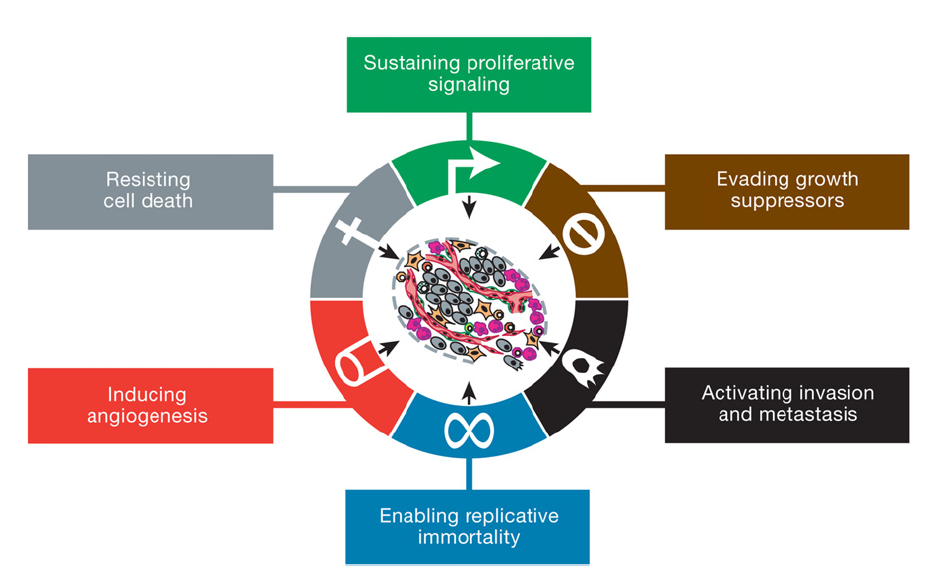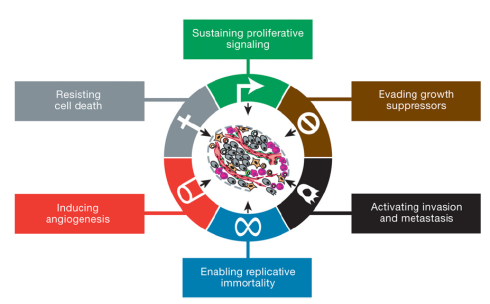The Hallmarks of Cancer: Becoming Independent

This article originally appeared on Know The Cosmos. I will be re-posting excerpts here for Australian Science with added commentary over the coming weeks!
“The Hallmarks of Cancer” are ten anti-cancer defense mechanisms that are hardwired into our cells, that must be breached by a cell on the path towards cancer. The First Hallmark of Cancer is defined as “Self-Sufficiency in Growth Signals”. Last week I explained what growth factors are and how signaling pathways work in a normal cell. In this article, I will go over how this process is hijacked by a cancer cell in its quest for achieving unlimited growth.
Becoming Independent
So now that we understand the basics of the molecular mechanisms behind cell signaling, what happens in a cancer cell that turns this orderly process so horribly awry? As you may have figured out, normal cells cannot divide without the ‘go ahead’ from growth factors. Even normal cells growing on a petri dish need growth factors supplied from animal serum to divide; if not they enter a dormant state and eventually die. Cancer cells on the other hand, do not need this ‘go ahead’. This liberation from being dependent on externally supplied growth factors removes a very critical checkpoint on the path towards cancer.
Breaching the Defenses
How do cancer cells bypass this checkpoint? There are three common strategies;
First, they can alter the level of growth signal itself. Normally, growth factors are made by one type of cell in order to act on another type of cell. However many cancer cells acquire the ability to synthesize and secrete their own growth factors, stimulating others of their kind, which creates a feedback loop in which more cancer cells divide under the influence of growth factor to synthesize more growth factor and so on. If the key to the lock is typically provided by a caretaker, then this means having your own DIY key-cutting machine, so that dependence on a locksmith is eliminated.
Second, the cancer cell can tweak the growth factor receptor itself, so that a larger-than-normal number of these receptors are present on the surface of the cancer cell. This means that the cancer cell becomes hyper-responsive to ambient levels of growth factor that would normally not be enough to trigger cell division. Additionally in some tumors, the growth factor receptor is structurally altered, sometimes lacking the regulatory regions, which results in the switch being permanently stuck at ‘on’. There is no need for a key, the lock opens without one.
Finally, there are alterations further downstream of the signaling pathway, so that the requirement for growth factor and receptor are both bypassed. For example, one of the key downstream components of the growth factor signaling pathway is a protein known as Ras. Mutant Ras is permanently ‘switched on’. Mutant Ras is the most common gene in human cancer; 25% of all human tumors, and up to 90% of certain types of cancer such as pancreatic cancer have mutant Ras. Why bother with trying to unlock a door if the walls don’t exist?
It is worth remembering that cancer cells cannot do what they do in isolation. The apparently normal bystanders, such as cells of the nearby blood vessels and connective tissue must also play key roles in driving cancer cell growth. In normal tissues, cells are instructed to grow by their neighbors; this is true of the tumor microenvironment as well. A tumor is not only made of cancer cells. Tumors should be regarded as complex tissues in which the mutant cancer cells have co-opted and subverted normal neighbor cells by inducing them to release growth factors as well.
With these three strategies for achieving self-sufficiency in growth signals, cancer cells can successfully breach one of the ten anti-cancer defenses hardwired into our normal cells. The result is cells that are capable of growing uncontrollably, unstoppably and pathologically – in other words, cancer cells.
This is the second of a series of articles that I will be writing about the Hallmarks of Cancer. This series is based on two review papers published by Robert Weinberg and Douglas Hanahan in the journal Cell. Both papers are Open Access, and you can download them here and here. The authors simplified cancer down to ten underlying principles, shared by every single cancer cell. Each of these ten changes in cell biology represent the successful breaching of an anticancer defense mechanism that is hardwired into our normal cells and tissues. These multiple defenses are the reason why we don’t all get cancer within hours of being born, or indeed being conceived!
Samarasinghe B (2013-09-16 06:50:57). The Hallmarks of Cancer: Becoming Independent. Australian Science. Retrieved: Jul 18, 2025, from https://ozscience.com/biology/the-hallmarks-of-cancer-becoming-independent/
 Follow
Follow
2 thoughts on “The Hallmarks of Cancer: Becoming Independent”
Comments are closed.